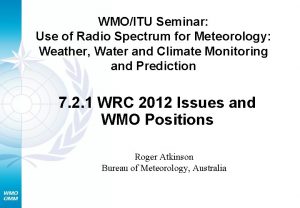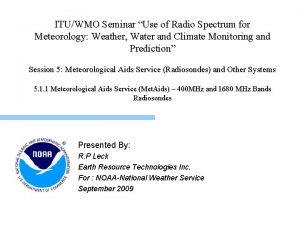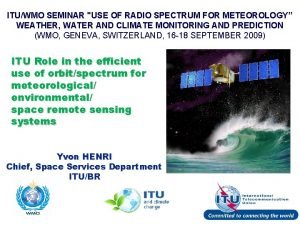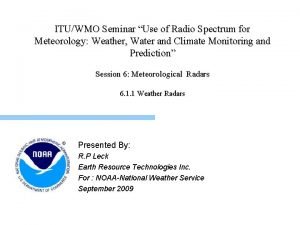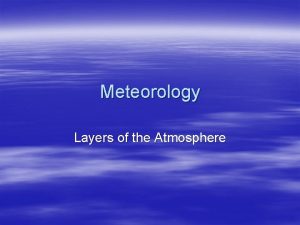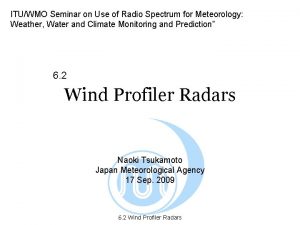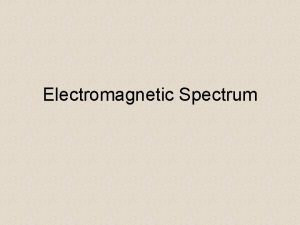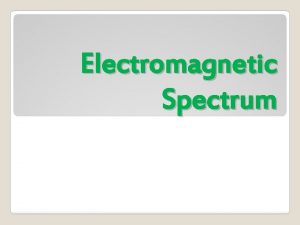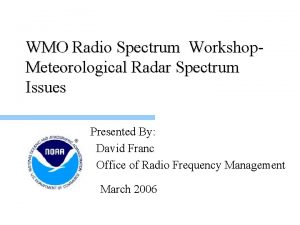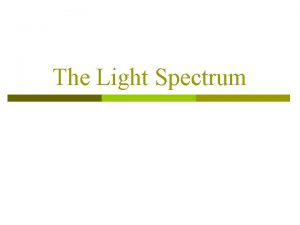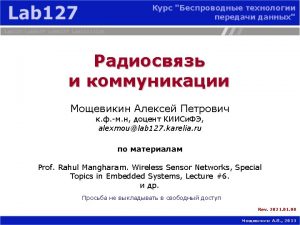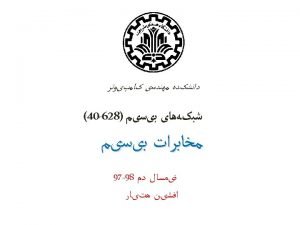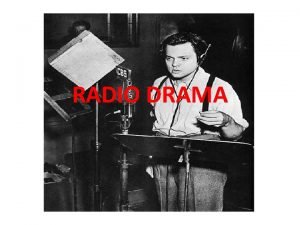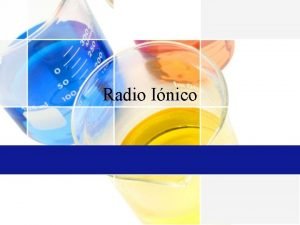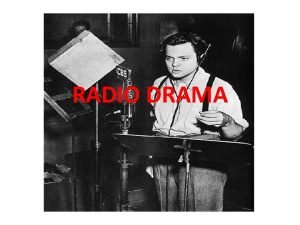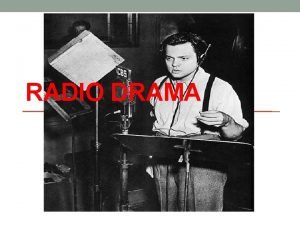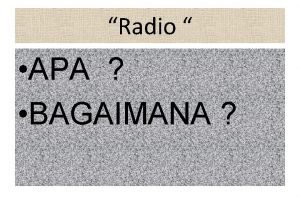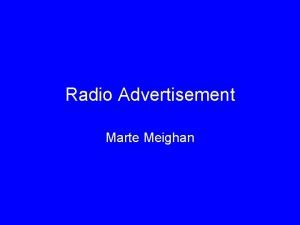WMOITU Seminar Use of Radio Spectrum for Meteorology



























- Slides: 27

WMO/ITU Seminar Use of Radio Spectrum for Meteorology Earth Exploration-Satellite Service (EESS)- Active Spaceborne Remote Sensing and Operations SRTM Radarsat JASON Seawinds TRMM Bryan Huneycutt (USA) Charles Wende (USA) WMO, Geneva, Switzerland 16 -18 September 2009 Cloudsat

WMO/ITU Seminar Use of Radio Spectrum for Meteorology Active Sensor Definition Active Sensor: an instrument which obtains information by the transmission and reception of radio waves.

WMO/ITU Seminar Use of Radio Spectrum for Meteorology Active Sensor Types • SYNTHETIC APERTURE RADARS – Cross-track looking sensors (one side only) which collect phase and delay time of coherent radar echoes; typical products include radar images and topographical maps of the Earth's surface. • ALTIMETERS – Downward looking sensors measuring the precise echo delay time to extract the precise altitude of the ocean's surface. • SCATTEROMETERS - Sensors looking at various aspects to the sides of the nadir track, measuring the return echo power variation with aspect angle to determine wind direction and speed on the ocean surface or return echo on the land surface. • PRECIPITATION RADARS – Cross-track looking sensors measuring the radar echo returned from rainfall to determine the rainfall rate. • CLOUD PROFILE RADARS – Downward-looking sensors measuring the radar echo returned from clouds to determine cloud reflectivity profile.

WMO/ITU Seminar Use of Radio Spectrum for Meteorology Active Sensor Types Notes: “[. . . ]” are past missions, “(. . . )” are future missions.

WMO/ITU Seminar Use of Radio Spectrum for Meteorology Synthetic Aperture Radars (SARs) • Provide radar images and by combining 2 images: - from different orbits →topographical maps of the Earth’s surface, or - taken at different times →maps indicating ground movement ~ centimeters (Interferometric SAR, or In. SAR) • RF center frequency depends on the Earth’s interaction with the EM field - lower frequencies (< 2 GHz) penetrate vegetation and reflect off the ground - higher frequencies reflect off water (rain, vegetation, etc. ) • RF bandwidth affects the resolution of the image pixels • Allowable image pixel quality degradation determines allowable interference level

WMO/ITU Seminar Use of Radio Spectrum for Meteorology The Radarsat image (right) shows two flooded areas in north central Bulgaria in early June 2005 with respect to the reference Landsat image (left). SARs (cont. )

WMO/ITU Seminar Use of Radio Spectrum for SARs (cont. ) Meteorology Los Angeles - SRTM with Landsat Overlay California-Height as color SRTM DEM's

WMO/ITU Seminar Use of Radio Spectrum for Meteorology In. SAR Image of the Mauna Loa Caldera in Hawaii Ground motion indicates Dangerous underground volcanic activity SARs (cont. )

WMO/ITU Seminar Use of Radio Spectrum for Meteorology RADARSAT-1 viewing Ice off Newfoundland And Labrador, Canada SARs (cont. )

WMO/ITU Seminar Use of Radio Spectrum for Meteorology Altimeters • Provide altitude of the Earth’s ocean surface • RF center frequency depends on the ocean surface interaction with the EM field • Dual frequency operation allows ionospheric delay compensation • JASON-1 uses frequencies around 13. 6 GHz and 5. 3 GHz • Allowable height accuracy degradation determines the allowable interference level Illustration of Altimeter Return

WMO/ITU Seminar Use of Radio Spectrum for Meteorology Altimeters (cont. )

WMO/ITU Seminar Use of Radio Spectrum for Meteorology Scatterometers • Provide the wind direction and speed over the ocean surface • RF center frequency depends on the ocean surface interaction with the EM field and its variation over aspect angle • Narrow RF signal bandwidth provides the needed measurement cell resolution • Allowable wind speed accuracy degradation determines the allowable interference level Variation of Backscatter with Aspect Angle

WMO/ITU Seminar Use of Radio Spectrum for Meteorology NSCAT illuminated the Earth’s surface at several different fixed aspect angles Ocean scatterometers SEAWINDS scanning pencil beam illuminates scans at two different look angles from nadir, and scans 360 degrees about nadir in azimuth

WMO/ITU Seminar Use of Radio Spectrum for Meteorology Scatterometers (contd)

WMO/ITU Seminar Use of Radio Spectrum for Meteorology Polar-orbiting scatterometers observe ocean over the entire world. Sea. WINDS on Quik. SCAT provided these data. Scatterometers (cont. )

WMO/ITU Seminar Use of Radio Spectrum for Meteorology Land scatterometers Aquarius scatterometer will illuminate the Earth’s surface at several different fixed aspect/nadir angle combinations SMAP scatterometer scanning pencil beam illuminates scans at fixed look angle from nadir, and scans 360 degrees about nadir in azimuth

WMO/ITU Seminar Use of Radio Spectrum for Scatterometers (cont. ) Meteorology Scatterometer looking at land – wet areas (blue) reflect back signals.

WMO/ITU Seminar Use of Radio Spectrum for Meteorology Precipitation Radars • Provide precipitation rate over the Earth’s surface, typically concentrating on rainfall in the tropics • RF center frequency depends on the precipitation interaction with the EM field • Narrow RF signal bandwidth provides the needed measurement cell resolution • Tropical Rainfall Measurement Mission (TRMM) uses only 0. 6 MHz RF bandwidth • Allowable minimum precipitation reflectivity degradation determines the allowable interference level

WMO/ITU Seminar Use of Radio Spectrum for Precip. Radars (cont. ) Meteorology The TRMM image shows the precipitation profile of the hurricane Ernesto on 26 August, 2006, revealing several deep convective towers (shown in red) that top out over 15 km.

WMO/ITU Seminar Use of Radio Spectrum for Meteorology Cloud Profile Radars • Provide three dimension profile of cloud reflectivity over the Earth’s surface • RF center frequency depends on the ocean surface interaction with the EM field and its variation over aspect angle • Antennas with very low sidelobes so as to isolate the cloud return from the higher surface return illuminated by the sidelobes • Narrow RF signal bandwidth provides the needed measurement cell resolution • Allowable reflectivity accuracy degradation determines the allowable interference level

WMO/ITU Seminar Use of Radio Spectrum for Meteorology NOAA’s GOES (top) showed Hurricane Ileana on Aug 23, 2006. Cloud. Sat's Cloud Profiling Radar produced profiles of Ileana's clouds (bottom). Cloud Profilers (cont. )

WMO/ITU Seminar Use of Radio Spectrum for Meteorology You have seen a variety of data products today's instruments can produce. Many* are available in a timely manner. Use them to your country's advantage. * some instruments are being demonstrated and are not in operational use.

WMO/ITU Seminar Use of Radio Spectrum for Meteorology And you can help Remind your administration that these useful instruments operate in allocated frequency bands and are given protection from interference.

WMO/ITU Seminar Use of Radio Spectrum for Meteorology ANNEX Additional details about the technques

WMO/ITU Seminar Use of Radio Spectrum for Meteorology Active Sensor Characteristics

WMO/ITU Seminar Use of Radio Spectrum for Meteorology Repeat Cycles, Swath Width and Orbital Characteristics for EESS (active)

WMO/ITU Seminar Use of Radio Spectrum for Meteorology Active Sensors Applications by Sensor Type
 Atomic size defination
Atomic size defination Absortpion
Absortpion Electromagnetic spectrum in order of increasing frequency
Electromagnetic spectrum in order of increasing frequency Awin support
Awin support Kontinuitetshantering i praktiken
Kontinuitetshantering i praktiken Novell typiska drag
Novell typiska drag Tack för att ni lyssnade bild
Tack för att ni lyssnade bild Returpilarna
Returpilarna Varför kallas perioden 1918-1939 för mellankrigstiden
Varför kallas perioden 1918-1939 för mellankrigstiden En lathund för arbete med kontinuitetshantering
En lathund för arbete med kontinuitetshantering Kassaregister ideell förening
Kassaregister ideell förening Tidbok yrkesförare
Tidbok yrkesförare A gastrica
A gastrica Vad är densitet
Vad är densitet Datorkunskap för nybörjare
Datorkunskap för nybörjare Tack för att ni lyssnade bild
Tack för att ni lyssnade bild Debattartikel mall
Debattartikel mall För och nackdelar med firo
För och nackdelar med firo Nyckelkompetenser för livslångt lärande
Nyckelkompetenser för livslångt lärande Påbyggnader för flakfordon
Påbyggnader för flakfordon Formel för lufttryck
Formel för lufttryck Svenskt ramverk för digital samverkan
Svenskt ramverk för digital samverkan Jag har nigit för nymånens skära
Jag har nigit för nymånens skära Presentera för publik crossboss
Presentera för publik crossboss Argument för teckenspråk som minoritetsspråk
Argument för teckenspråk som minoritetsspråk Vem räknas som jude
Vem räknas som jude Klassificeringsstruktur för kommunala verksamheter
Klassificeringsstruktur för kommunala verksamheter Epiteltyper
Epiteltyper




























